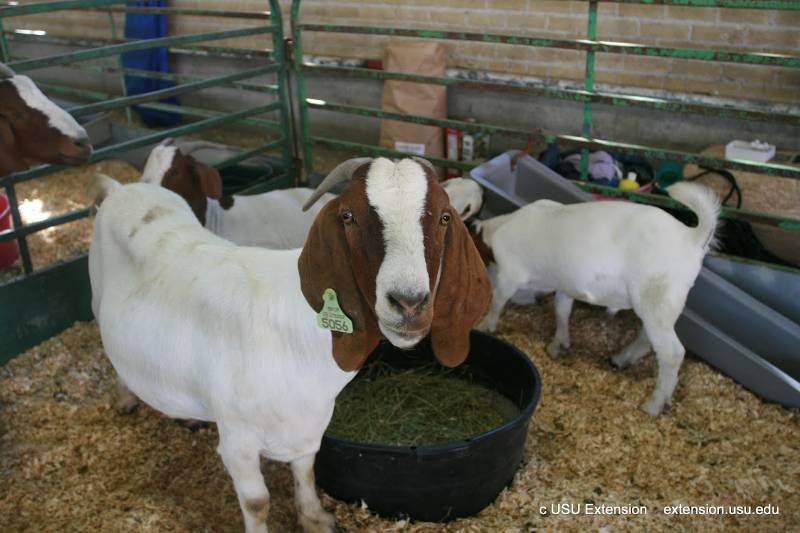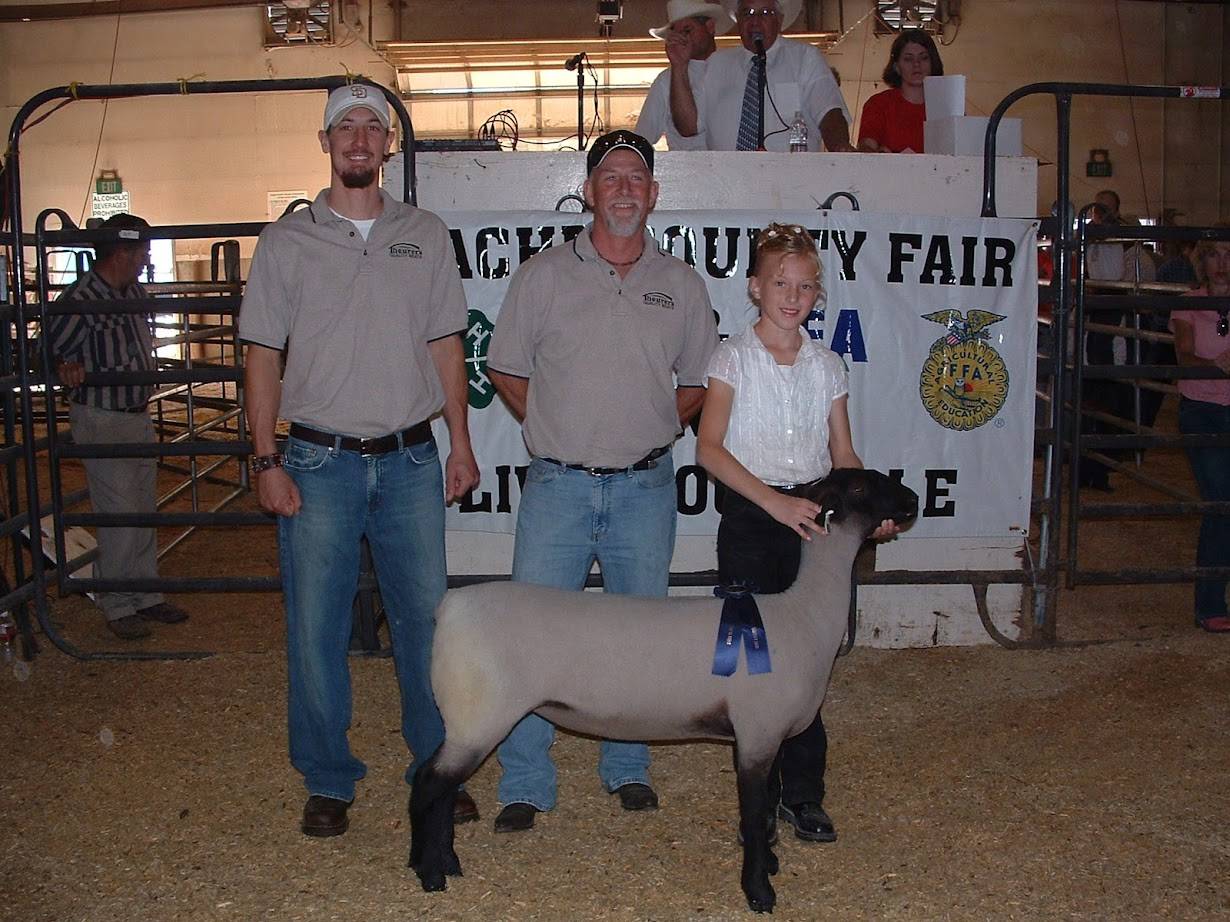Market Animal Feed Efficiency: A Tool for Evaluating Feed Conversion

Why monitor a market animal’s feed cost and weight gain?
Junior livestock producers usually aim to raise a quality market animal, compete in the show ring, and hopefully, make a profit. These goals don’t need to be at odds. Junior producers should understand that raising a quality animal can be profitable too. Regular monitoring of a market animal’s feed efficiency can maximize an animal’s potential and greatly increase a junior producer’s chances of making a profit. After purchasing a market animal, feed is the most expensive input. Therefore, profit earned for the average market animal is greatest when feed cost is managed.
Is the priciest show feed the best?

Young producers can sometimes fall into the trap set by clever marketing and think that the more spent on feed, the greater the return. This is not always the case. Finding the best feed is more complicated than spending more money on a product. Each market animal differs in its environment and genetics and each animal will respond to any given feed or supplement differently (Shike, 2013; Claffey, et al., 2018; Cameron et al., 2001; Stender, 2012). For example, the nutrition requirements for a quality lamb with a high level of daily activity will differ from another that receives very little activity. Both animals have potential to be excellent lambs but the first lamb may need more calories to produce muscle than the second. If the second lamb is fed a product that works well for the first lamb, instead of producing lean muscle, the lamb may become over-conditioned because of its lower energy requirements.
Genetics also play a role in an animal’s ability to do well on different products (Stender, 2012). An extreme example of this is the difference in nutrient requirements between species. Hog feeds don’t meet the nutrient requirements for lambs and vice versa. Likewise, lambs with different body shapes and frame sizes require different feed formulations and content to reach their full potential.

What does feed efficiency mean?
The amount of feed required to increase a market animal’s weight by 1 pound is called the feed conversion efficiency (FCE). For example, if a market hog fed 3 pounds of feed gains 1pound, it has an FCE ratio of 3-to-1. Examples of feed efficiencies for several livestock species are displayed in Table 1. Note that feed efficiencies can be slightly improved or greatly reduced beyond the values shown in Table 1.
| Table 1. Examples of More and Less Efficient Feed Conversion Efficiencies for Listed Species | |||
|---|---|---|---|
| Species | Feed conversion efficiency (lb. DMI/lb. ADG) | Publication | |
| More efficient | Less efficient | ||
| Cattle | 4.5 | 7.5 | Shike (2013)a |
| Sheep | 4.1 | 11.7 | Claffey et al. (2018)b |
| Goats | 3.9 | 10.5 | Cameron et al. (2001); Lewis et al. (1997)c |
| Hogs | 2.6 | 3.5 | Stender (2012)d |
aShike (2013) provides a typical FCE range for feedlot steers.
bThe more efficient value represents lambs fed a high concentrate diet for 36 days in comparison to the less efficient value of lambs fed a 50:50 concentrate and roughage diet for 72 days.
cObservations are from two studies of Boer x Spanish and Spanish goats fed high concentrate diets.
dThe values represent cumulative FCE for contemporary hogs finished at 250 lb. (more efficient) in contrast with hogs from 50 years ago (less efficient).
Different ration compositions explain why less efficient lambs in Table 1 use 2.8 times the feed for the same increase in body mass as the more efficient lambs. Less efficient cattle, goats, and hogs in Table 1 consume 1.7, 2.7 and 1.4 times more feed, respectively, than the more efficient groups shown in Table 1. These differences are less clear, but they may be explained by a combination of genetics, rations, and environment. Regardless, less efficient animals and rations use significantly more feed. Consider the differences in production costs for feeding each group from the examples in Table 1. The increase in cost becomes substantial over time as seen in Table 2.
| Table 2. Cost of Producing Body Mass for Listed Species Under High and Low Efficiency Scenarios | |||
|---|---|---|---|
| Species | Cost per pound of gaina | Cumulative cost difference per 100 pounds |
|
| More efficient | Less Efficient | ||
| Cattle | $2.25 | $3.75 | $170 |
| Sheep | $2.05 | $5.85 | $280 |
| Goats | $1.95 | $5.25 | $270 |
| Hogs | $1.30 | $1.75 | $140 |
aCost is based on a feed price of $0.50/pound.
Feed efficiency is also useful for evaluating whether changes made to a ration are beneficial, ineffective, or detrimental. When doing this, it is important to include an animal’s average daily gain (ADG) in the decision-making process because there are times when significant weight gain outweighs the desire for efficient weight increase. For example, when a young animal needs to grow faster to meet the weight requirements of the junior livestock show. However, changes to feed efficiency—or the lack thereof—can provide information about the quality of the ration or whether the changes made provide economic value.
How is an animal’s feed conversion efficiency calculated?
Dividing the pounds of feed provided each day by the animal’s average daily weight gain give the feed conversion efficiency.
Step 1. Calculate the animal’s average daily gain. (Learn to calculate an animal’s average daily gain by visiting the livestock weight calculator tool.)
Step 2. Measure the weight of the animal’s daily ration.
Step 3. Input the measured values into the equation.
Daily Ration / Average Daily Gain = Feed Conversion Efficiency
Example:
2.2 lbs. / 0.6 ADG = 3.7
How is feed efficiency converted into cost per pound of gain?
Step 1. Divide 1 pound by the number of pounds of feed purchased and then multiply it by the purchase price.
1 lb. / Pounds Purchased x Price of Pounds Purchased = Price per Pound
Example:
1 lb. / 50-lb. Bag x $25 per Bag =$0.50
Step 2. Multiply the cost per pound by the feed conversion efficiency.
Cost per Pound × Feed Efficiency = Cost per Pound of Gain
Example:
$0.50×3.7=$1.85
Conclusion
Feed efficiency is useful for understanding a market animal’s ability to convert feed into mass. It is also one of many variables affecting the cost of raising market animals. Young producers should consider using FCE and ADG to evaluate the performance of their animals on feed, nutrition supplements, or other products that make the daily ration. If the animal’s FCE and ADG are poor, or if the ration has been changed recently and the FCE and ADG don’t increase significantly, it might be worth it to change the ration or evaluate the cost of the previous changes. In addition to feed efficiency and average daily gain, there are many other nutrition components that should be considered. (Find out more about market animal nutrition by reading the nutrition quick tips.)
References
- Cameron, M. R., Luo, J., Sahlu, T., Hart, S. P., Coleman, S. W., & Goetsch, A. L. (2001). Growth and slaughter traits of Boer x Spanish, Boer x Angora, and Spanish goats consuming a concentrate-based diet. Journal of Animal Science, 79(6), 1423. https://doi.org/10.2527/2001.7961423x.
- Claffey, N. A., Fahey, A. G., Gkarane, V., Moloney, A. P., Monahan, F. J., & Diskin, M. G. (2018). Effect of forage to concentrate ratio and duration of feeding on growth and feed conversion efficiency of male lambs. Translational Animal Science, 2(4), 419–427. https://doi.org/10.1093/tas/txy071.
- Lewis, S. J., May, B. J., Engdahl, G. R., Waldron, D. F., Scott, C. B., & Shelby, D. R. (1997). Feedlot performance and carcass traits of Boer goat crosses and Spanish male kids [Abstractc]. Journal of Animal Science, 75(Suppl. 1), 40.
- Shike, D. (2013). Beef cattle feed efficiency [Conference session]. Driftless Range Beef Conference, Dubuque, IA, United States. https://dr.lib.iastate.edu/entities/publication/dd175f9a-824e-4ac3-9b79-f56551ad8d13.
- Stender, D. (2012). Swine feed efficiency: Influence of market weight [Fact sheet]. Iowa State University. https://dr.lib.iastate.edu/handle/20.500.12876/4997.
June 2022
Utah State University Extension
Peer-reviewed fact sheet
Authors
Cody Zesiger, Jessie Hadfield, Jacob Hadfield, and Joshua Dallin





